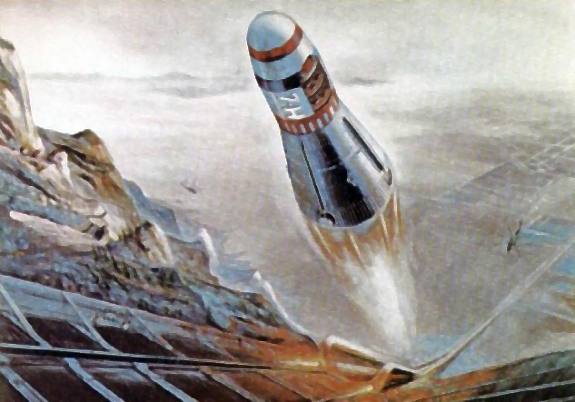A discussion in the 'single stage to orbit' thread got me to thinking.
... I put this into the 'Addon Requests' as I think this would be a good addon launcher / base ... if I can find the time I may even attempt it someday myself ...
I know I had read in one of my scifi novels in the past about a rail launch system to give a ship an initial boost to get it on it's way.
Some google searching didn't turn up a lot, and I can't find much on it here in the forums.
Some plans have been looked at in the past, but info is scarce.
Anyway, my idea is basically a sled riding a rail running up the side of a mountain. Something like the Hyperion SSTO plan http://www.astronautix.com/lvs/hypnssto.htm
The sled would probably be riding multiple rails (don't know that maglev could hold 200+ tons off the rails) ... propulsion for the sled would probably best be performed by basically a linear magnetic motor along the rail ... I'm sure the base/launcher system would probably have to have a dedicated nuclear power plant to provide the power needed.
Location, not sure, but Kilimanjaro seems the best so far. A few kilometers of runup to gain some momentum, then a swoop up the slope to release the 'payload' at about 5.8 km altitude (according to Google's terrain map) at a high subsonic velocity ... could possibly be ramped up for even greater speed, haven't figured out the math yet. Lot's of things to work out ... power consumption, stability, maxQ, not to mention the undertaking such a real-world project would be in a remote location.
A few quick runs with an empty XR5 took anywhere from 14% - 20% of the fuel to reach that altitude and speed on realistic settings, but I admit I wasn't trying real hard ... even assuming it only taking 10% of the fuel, that was flying it empty. Loading the bay up with a heavy payload would use much more.
The launch base done as a vessel so that it could 'attach' and release it's payload from the sled, it would be at least a few kilometers long.
Not sure of the real world practicality, but I can't get this image of an XR5 being catapulted up the side of a mountain and released. I would love to have a system like this.
I would love to have a system like this.
Any thoughts on a better location? Would this be something worth pursuing?
... sorry for the ramble on this one ...
:huh:
... I put this into the 'Addon Requests' as I think this would be a good addon launcher / base ... if I can find the time I may even attempt it someday myself ...
I know I had read in one of my scifi novels in the past about a rail launch system to give a ship an initial boost to get it on it's way.
Some google searching didn't turn up a lot, and I can't find much on it here in the forums.
Some plans have been looked at in the past, but info is scarce.
Anyway, my idea is basically a sled riding a rail running up the side of a mountain. Something like the Hyperion SSTO plan http://www.astronautix.com/lvs/hypnssto.htm
The sled would probably be riding multiple rails (don't know that maglev could hold 200+ tons off the rails) ... propulsion for the sled would probably best be performed by basically a linear magnetic motor along the rail ... I'm sure the base/launcher system would probably have to have a dedicated nuclear power plant to provide the power needed.
Location, not sure, but Kilimanjaro seems the best so far. A few kilometers of runup to gain some momentum, then a swoop up the slope to release the 'payload' at about 5.8 km altitude (according to Google's terrain map) at a high subsonic velocity ... could possibly be ramped up for even greater speed, haven't figured out the math yet. Lot's of things to work out ... power consumption, stability, maxQ, not to mention the undertaking such a real-world project would be in a remote location.
A few quick runs with an empty XR5 took anywhere from 14% - 20% of the fuel to reach that altitude and speed on realistic settings, but I admit I wasn't trying real hard ... even assuming it only taking 10% of the fuel, that was flying it empty. Loading the bay up with a heavy payload would use much more.
The launch base done as a vessel so that it could 'attach' and release it's payload from the sled, it would be at least a few kilometers long.
Not sure of the real world practicality, but I can't get this image of an XR5 being catapulted up the side of a mountain and released.
Any thoughts on a better location? Would this be something worth pursuing?
... sorry for the ramble on this one ...
:huh:

